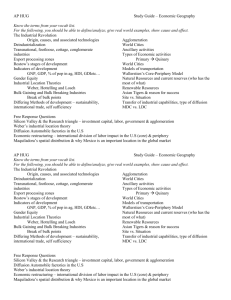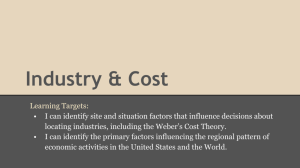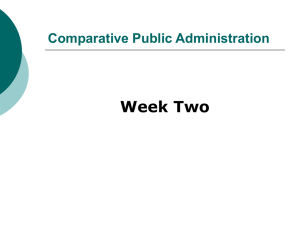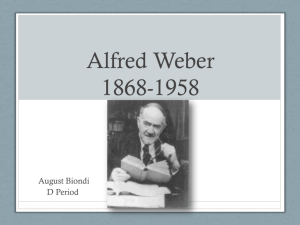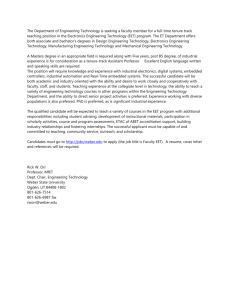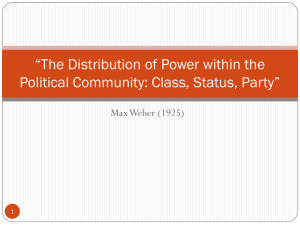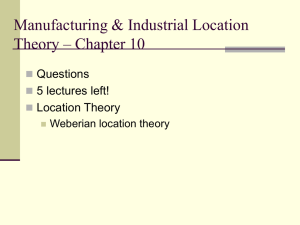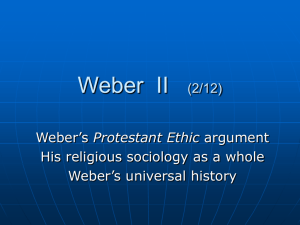industrial theory
advertisement
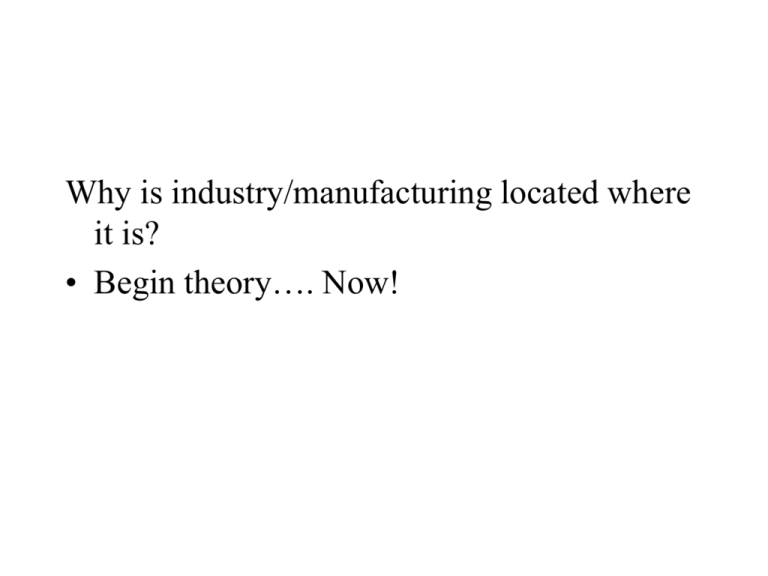
Why is industry/manufacturing located where it is? • Begin theory…. Now! The Paris Basin is the Industrial base of France. Rouen (above) is at the head of navigation point on the Seine River. Location Theory • Location Theory – predicting where a business will or should be located. • Location of an industry is dependent on economic, political, cultural features as well as whim. • Location Theory Considers: – Variable costs-energy, transportation costs & labor costs – Friction of distance-increasing distance =increased time & cost Alfred Weber Location Models Weber’s Model-The Least Cost Theory Alfred Weber, (1868-1958) a German economists, published Theory of the Location of Industries in 1909. His theory was the industrial equivalent of the Von Thunen Model. Manufacturing plants will locate where costs are the least. Categories of Costs: Transportation-the most important cost-usually the best site is where cost to transport raw material and finished product is the lowest Labor-high labor costs reduce profit-location where there is a supply of cheap, non-union labor may offset transportation costs Agglomeration-when a group of industries cluster for mutual benefitshared services, facilities, etc.-costs can be lower Deglomeration-when excessive agglomeration offsets advantageeastern crowded cities Weber’s Least-Cost Theory One of his core assumption is that firms will chose a location in view to minimize their costs. Theformulated Basics a theory of Alfred Weber industrial location in which an industry is located where the transportation costs of raw materials and final product is a minimum. In one the weight of the final product is less than the weight of the raw material going into making the product. This is the weight losing or BULK-REDUCING industry. Ex: Copper production steel production BULK-GAINING • In the other the final product is heavier than the raw material that require transport. • Usually this is a case of a raw material such as water being incorporated into the product. • This is called the weight-gaining or BULK – GAINING industries. • What happens when a variety of materials is needed for the production? – Production point moves closer to the heaviest raw material to balance transportation costs. ENERGY SOURCE?? The availability of an energy supply is another factor in the location of industry, but the factor used to be much more important than it is today. The early British textile mills were site-tied” because they depended on falling water to drive the looms. Today, power comes from different sources and can be transmitted or transported over long distances. Exceptions occur when an industry needs very large amounts of energy, for example, certain metallurgical and chemical industries. Location Models • Hotelling’s Model-Harold Hotelling (1895-1973) this economist modified Weber’s theory by saying the location of an industry cannot be understood with out reference to other similar industries-called Locational Interdependence • Losch’s Model-August Losch said that manufacturing plants choose locations where they can maximize profit. Theory: Zone of Profitability How has Industrial Production Changed? How has Industrial Production Changed? Fordist – dominant mode of mass production during the twentieth century, production of consumer goods at a single site. Post-Fordist – current mode of production with a more flexible set of production practices in which goods are not mass produced. Production is accelerated and dispersed around the globe by multinational companies that shift production, outsourcing it around the world. Time-Space Compression • Just-in-time delivery rather than keeping a large inventory of components or products, companies keep just what they need for short-term production and new parts are shipped quickly when needed. Global division of labor corporations can draw from labor around the globe for different components of production. Modern Production Outsourcing – moving individual steps in the production process (of a good or a service) to a supplier, who focuses their production and offers a cost savings. Offshore – Outsourced work that is located outside of the country. Nike (A Light Industry)-Headquartered in Beaverton, Oregon, Nike has never produced a shoe in Oregon. Beginning in the 1960s, Nike contracted with an Asian firm to produce its shoes. Skopje, Macedonia-The swoosh is ubiquitous, but where is the shoe produced? Nike has a global network of international manufacturing and sales. Outsourcing vs. offshoring Maquiladora Part 2 wage growth? New Influences on the Geography of Manufacturing • Transportation-intermodal connections where air, rail, truck, ship and barge connect-eases flow of goods-e.g. container shipping… Break of Bulk points. New Influences on the Geography of Manufacturing • Regional and global trade agreements-WTO, Benelux, European Union, NAFTA, MERCOSUR, SAFTA, CARICOM, ANDEAN AFTA, COMESA, etc. goal to ease flow of goods by eliminating trade tariffs or quotas • Energy-coal was replaced by natural gas & oil after WW II-transported by pipeline or tanker • Europe-despite North Sea Oil-still must import • Mexico & Canada oil and natural gas • U.S. uses 27% if oil & 37% of natural gas produced in the world. Dependent on imported oil… Impact of the Bakken??? • OPEC: Saudi Arabia, Kuwait, Iraq, Russia large oil reserves Deindustrialization – a process by which companies move industrial jobs to other regions with cheaper labor, leaving the newly deindustrialized region to switch to a service economy and work through a period of high unemployment. Abandoned street in Liverpool, England, where the population has decreased by onethird since deindustrialization Liverpool Detroit The Rust Belt vs The Sun Belt THE END

